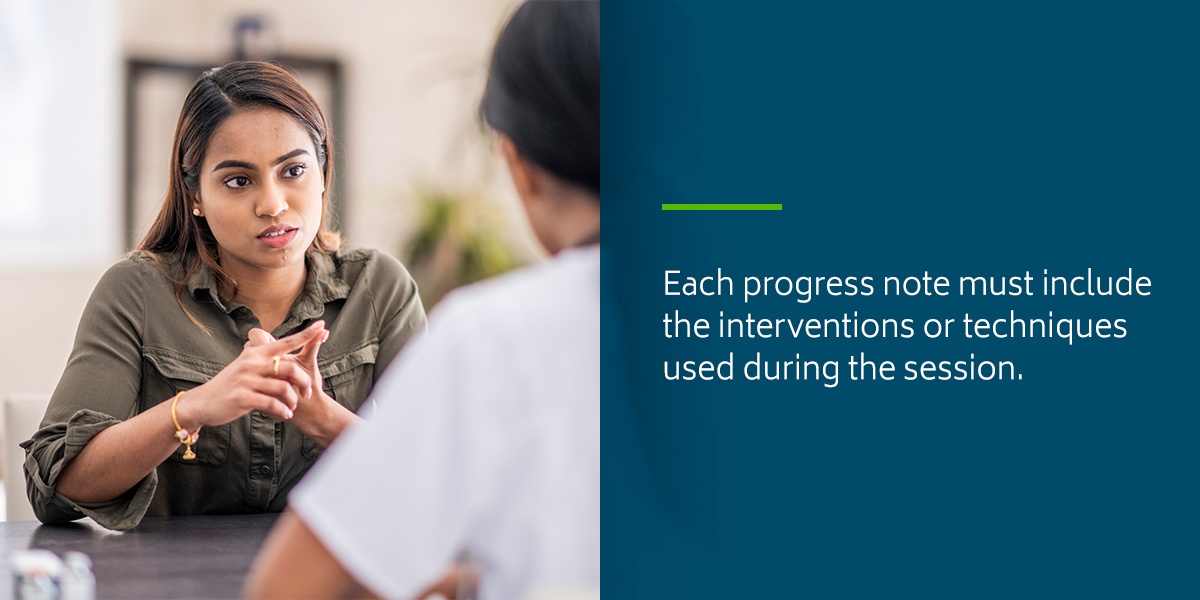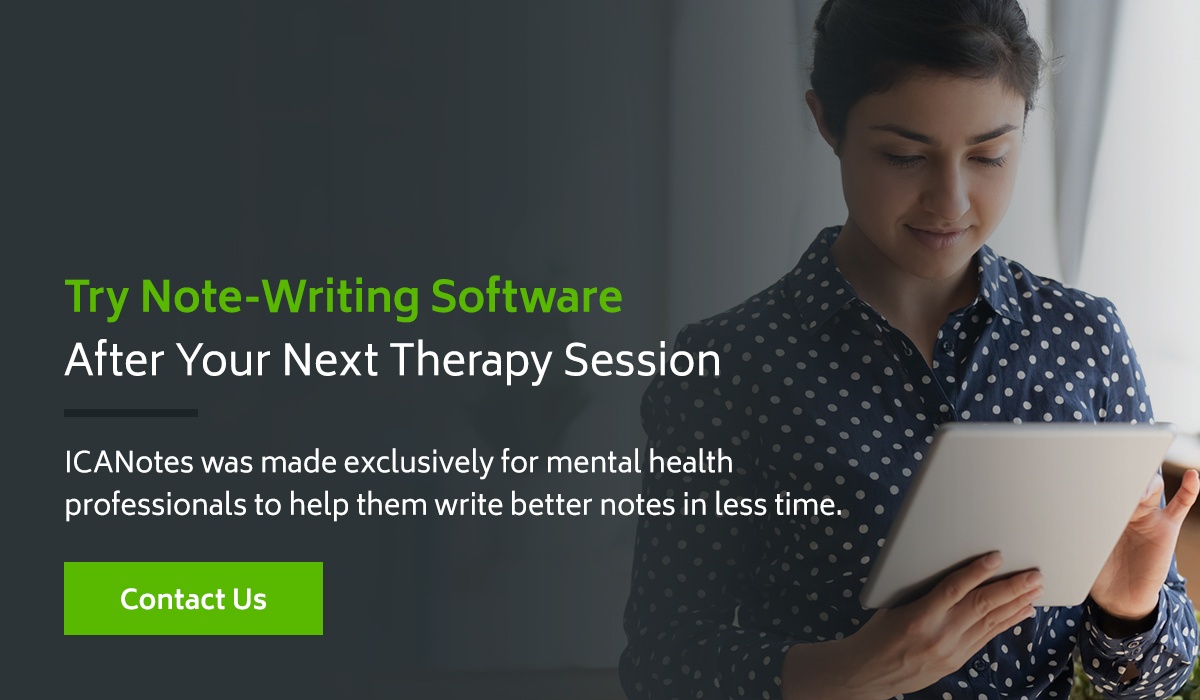The 10 Essential Elements of Any Progress Note
If you've spent any amount of time in a therapy clinic, you'll appreciate the importance of a thorough case note. Progress notes are absolutely indispensable for accurate recall, treatment monitoring and effective collaboration. They are also critical documents for insurance reimbursement. To make any progress note effective and useful for insurance purposes, we recommend ensuring yours contain these 10 essential elements:
Table of Contents
- Demographic Information
- Diagnosis
- Presenting Problem
- Safety Concerns
- Medications
- Symptom History
- Current Mental Status
- Interventions Used
- Treatment Plan Goals and Objectives
- Progress
- Types of Progress Notes
- How to Write Progress Notes for Therapy Clients
- Try Note-Writing Software After Your Next Therapy Session
1. Demographic Information
Begin with basic demographic data, such as the client's age, ethnicity, gender and employment and marital status. You'll want to mention any relevant facts about the client's current living situation and occupation. This objective information can offer valuable insight for forming a diagnosis and developing a mental health treatment plan.
2. Diagnosis
Any type of progress note needs to include a diagnosis related to the services you provide to get reimbursed. That's because insurance companies want proof that a client's treatment is medically necessary. Diagnoses also guide you and your clients as you develop their treatment goals and objectives. Be sure to include the International Classification of Diseases (ICD) code with the diagnosis for billing purposes.
3. Presenting Problem
When recording a client's presenting problem, it helps to document as much as possible in the client's own words and avoid paraphrasing. When you review your progress notes later, you may find a critical subtext that can benefit a client's care.
4. Safety Concerns
Clearly and accurately document any comments your client makes suggesting a plan to self-harm. It's essential other healthcare professionals can read your notes in an emergency intervention.
5. Medications
Pay special attention to the medications a client takes, as these can affect their mental health. List all of your client's current medications, including the name, dosage and side effects. Keep this section up to date.
6. Symptom History
What is the entire history of your client's symptoms? Have their symptoms impacted their jobs or relationships throughout their life? What have they done over the years to address their symptoms? Have they had any success, and if not, what went wrong?
Along with your client's mental health history, make sure to document any physical factors related to their diagnosis. Progress notes should include a complete psychological and medical history to understand a client's condition.
7. Current Mental Status
As you observe your client, you'll want to record their mood, appearance and unusual behaviors to grasp their current mental health status. Although you do not need to describe everything a client is wearing, for example, you will want to ensure your notes are comprehensive to provide insight later on. A mental status exam cheat sheet can guide you through this part of the note-writing process.
8. Interventions Used
Each progress note must include the interventions or techniques you used during the session to address the client's presenting problem and how they responded. For example, could the client demonstrate the skill you taught them? Do they know how to apply the skill at home? Were they not interested, or did they refuse to participate? You should also describe the main topics discussed during the session.
9. Treatment Plan Goals and Objectives
Progress notes need to address the client's treatment goals and objectives. The client's goals directly relate to their diagnosis, and their objectives are the smaller, measurable steps they have to take to reach their goals. Include how your interventions will help the client progress toward goals. In addition, write what the client will do between sessions, such as homework assignments, to reach goals.
10. Progress
Insurance companies want to know that your services are helping a client get better or keeping their symptoms from worsening. A client's progress, or lack thereof, also shows whether you need to adjust their mental health treatment plan. Any progress note should include a summary of the client's movement toward their treatment goals and objectives to demonstrate efficacy and a need for continued services. If there is no progress or setbacks, explain why. Use this information to modify the client's treatment goals or therapeutic strategies.
Types of Progress Notes
You can write comprehensive progress notes using one of several forms. Your agency likely already has an established format to follow, but if you're starting your own practice, you'll need to consider how you'll organize your notes.
Here are a few of the most commonly used progress note formats:
- SOAP: SOAP is an acronym for subjective, objective, assessment and plan. The SOAP format is a widely used note-writing method because it's thorough yet concise. It also serves as a cognitive aid, helping mental health professionals use their clinical reasoning skills.
- BIRP: BIRPstands for behavior, intervention, response and plan. Like SOAP notes, BIRP notes include a counselor's observations and a plan to help clients reach their treatment goals. But the BIRP format combines objective and subjective details under the behavior section. BIRP notes also focus more heavily on the interventions counselors use to address a client's goals during a therapy session and how the client responds to the intervention.
- DAP: DAP is an acronym for data, assessment and plan. In the data portion, counselors record their observations. They then use the assessment section to interpret the data component and note if the client is or isn't making progress. The final portion describes the plan for future treatment. Some organizations may prefer DAP notes to minimize confusion about subjective and objective elements.
Any of the above note-writing templates can help you deliver effective counseling and get reimbursed by insurance companies.
How to Write Progress Notes for Therapy Clients
Regardless of the note-writing format you choose, your notes must demonstrate how your services address the presenting problem and help a client progress. It's also essential that your notes are accurate, clear and thorough to communicate the client's care with other practitioners. Here are a few tips to writing effective progress notes:
- Write immediately after sessions: It's better not to wait until the end of the day to take notes. Instead, writing your notes immediately after each session helps with accuracy and can keep you from feeling overwhelmed. Aim to set aside around 10 minutes after each session for writing progress notes.
- Emphasize the most important details: Ensure your progress notes include essential information to jog your memory for the next session. Those details may consist of homework you assigned or interventions you plan to use during the next appointment with a client.
- Be objective: Keep your progress notes as objective as possible. Avoid words like "appears" and "seems" and only include specific and factual information. You'll also want to avoid using judgmental language. Remember, your clients and other clinicians may read your progress notes.
- Be clear and concise: Only include relevant information to keep your notes brief, clear and quick to read. Also, only use approved abbreviations and acronyms. Otherwise, keep your notes as simple as possible.
Try Note-Writing Software After Your Next Therapy Session
Writing your progress notes can be part of an efficient workflow. The key is to use a note-writing format that works best for you and your team. With ICANotes electronic health record (EHR) software, you can find your preferred format or customize our note-writing templates to suit your needs.
ICANotes was made exclusively for mental health professionals to help them write better notes in less time. To experience ICANotes firsthand, sign up for your free trial today. Have questions? Please reach out to our customer support team — we'll be happy to assist you.
Last updated July 23, 2021.
Related Posts
Billing Pitfalls for Mental Health Clinicians
What Is the Difference Between a Clearinghouse Rejection and a Payer Denial?
Biggest Challenges Behavioral Health Clinicians Will Face in 2021



